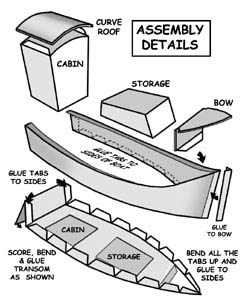


Lobster Cannery - $$5.95
Until the early 1800s, lobstering was done by gathering them by hand along the shoreline. Lobstering as a trap fishery came into existence in Maine around 1850. Today Maine is the largest lobster-producing state in the nation. Though the number of lobstermen has increased dramatically, the amount of lobsters caught has remained relatively steady. These little shacks actually live in the picturesque harbor at Lubec, Maine.
New England Lobster Cannery-downloadable Cardmodel
 This lovely high resolution and framable watercolor of the Cannery by our artist Derek Carter, is included with your model. Print to any size. |
 |
Long ago, lobsters were so plentiful
that Native Americans used them to fertilize their fields and
to bait their hooks for fishing. In colonial times, lobsters
were considered "poverty food." They were harvested from tidal
pools and served to children, to prisoners, and to indentured
servants, who exchanged their passage to America for seven years
of service to their sponsors. In Massachusetts, some of the
servants finally rebelled. They had it put into their contracts
that they would not be forced to eat lobster more than three
times a week.
Until the early 1800s, lobstering was done by gathering them
by hand along the shoreline. Lobstering as a trap fishery came
into existence in Maine around 1850. Today Maine is the largest
lobster-producing state in the nation. Though the number of
lobstermen has increased dramatically, the amount of lobsters
caught has remained relatively steady. In 1892, 2600 people
in the Maine lobster fishery caught 7,983 metric tons; in 1989,
6300 Maine lobstermen landed 10,600 metric tons of lobster....
What people say...
 When I first got the keys for the buildings, I thought there
had been a mistake. I was on the AIRCRAFT list for heaven's
sake! But I was told that it was ok and I downloaded them.
You've really outdone yourself Chip. I've been very impressed
with what you've done lately. Keep up the good work!.....Mike
When I first got the keys for the buildings, I thought there
had been a mistake. I was on the AIRCRAFT list for heaven's
sake! But I was told that it was ok and I downloaded them.
You've really outdone yourself Chip. I've been very impressed
with what you've done lately. Keep up the good work!.....Mike
Wonderful work, as usual. Thanks....Lynn
Bought this great model -- thanks! But no little models of actual lobsters?? I see the seagulls but am I missing the lobs? Thanks, Deb
Thank you. I was raised in New England. These Fiddlers Green creations are bringing back fond memories......Bob P
Loved the Cannery, but more on screen than on download as the red color not only dominates, but is exclusive, even on Sheet3. Perhaps the set-up needs a tweek on your end. Anyway, I loved it - and the brief history on Lobsters. Cheers....Duane
This Cannery is great. These new building models are really a step ahead of the rest. Keep up the great work Chip! Phil H
Lobstering History
 Long ago, lobsters were so plentiful that Native Americans used
them to fertilize their fields and to bait their hooks for fishing.
In colonial times, lobsters were considered "poverty food."
They were harvested from tidal pools and served to children, to
prisoners, and to indentured servants, who exchanged their passage
to America for seven years of service to their sponsors. In Massachusetts,
some of the servants finally rebelled. They had it put into their
contracts that they would not be forced to eat lobster more than
three times a week.
Long ago, lobsters were so plentiful that Native Americans used
them to fertilize their fields and to bait their hooks for fishing.
In colonial times, lobsters were considered "poverty food."
They were harvested from tidal pools and served to children, to
prisoners, and to indentured servants, who exchanged their passage
to America for seven years of service to their sponsors. In Massachusetts,
some of the servants finally rebelled. They had it put into their
contracts that they would not be forced to eat lobster more than
three times a week.
Until the early 1800s, lobstering was done by gathering them by hand along the shoreline. Lobstering as a trap fishery came into existence in Maine around 1850. Today Maine is the largest lobster-producing state in the nation. Though the number of lobstermen has increased dramatically, the amount of lobsters caught has remained relatively steady. In 1892, 2600 people in the Maine lobster fishery caught 7,983 metric tons; in 1989, 6300 Maine lobstermen landed 10,600 metric tons of lobster.
Smackmen first appeared in Maine in the 1820s because of increased demand for lobsters from the New York and Boston markets. Smackmen were named after their boats, a well smack. Smacks were small sailing vessels with a tank inside the boat that had holes drilled into it to allow sea water to circulate. The smacks were used to transport live lobsters over long distances.
 The
first lobster pound appeared on Vinalhaven in 1875 and others quickly
followed. Lobster pounds work in the same manner as the smack boats.
The lobsters are kept in tanks with water passing freely through
them. The first lobster pound was in a deep tidal creek, but today
they are more common on docks floating in the harbor. Using the
pound, dealers can wait for the price of lobster to increase or
allow a newly-molted lobster time to harden its shell.
The
first lobster pound appeared on Vinalhaven in 1875 and others quickly
followed. Lobster pounds work in the same manner as the smack boats.
The lobsters are kept in tanks with water passing freely through
them. The first lobster pound was in a deep tidal creek, but today
they are more common on docks floating in the harbor. Using the
pound, dealers can wait for the price of lobster to increase or
allow a newly-molted lobster time to harden its shell.
By the 1930s, the traveling smackmen were being replaced by local, land-based buyers who served as the link between the harvesters and the public.
The buyer purchased lobsters from a harvester who in turn bought
fuel, bait, and other gear from the buyer. The local buyer then
either sold the lobsters to people who came down to the docks or
turned them over to a regional dealer who sent the lobsters out
of state.
 In response to demand for lobster that exceeded the range of the
smack boats, lobsters were canned beginning in 1836. The Burnham
& Morrill Company was one of the early canneries in existence
in Maine. Now primarily in the baked bean business, B&M was
canning lobsters and sending them to all parts of the habitable
globe, according to an 1880 history of Cumberland County, Maine.
Canning the lobsters overcame some of the difficulties associated
with shipping lobsters, and by the second half of the 19th century
the value of canned lobster had surpassed that of live lobster.
In response to demand for lobster that exceeded the range of the
smack boats, lobsters were canned beginning in 1836. The Burnham
& Morrill Company was one of the early canneries in existence
in Maine. Now primarily in the baked bean business, B&M was
canning lobsters and sending them to all parts of the habitable
globe, according to an 1880 history of Cumberland County, Maine.
Canning the lobsters overcame some of the difficulties associated
with shipping lobsters, and by the second half of the 19th century
the value of canned lobster had surpassed that of live lobster.
The canneries were so efficient at processing the lobsters that they were soon forced to work with smaller lobsters. In 1860, James P. Baxter recalled that four to five pound lobsters were considered small and the two pound lobsters were being discarded as not worth the effort to pick the meat for canning. Only twenty years later, the canneries were stuffing meat from half-pound lobsters into the tins for processing.
During World War II lobster was considered a delicacy, and consequently was not rationed. Thus lobster meat filled the increasing demand for protein-rich food. People could afford it because of the boom of the war-time economy. Although there was a decline in lobster purchases immediately after the war, lobster consumption rapidly rebounded. In the years between 1950 and 1969, per capita lobster consumption increased from .585 pounds (live weight) to .999 pounds. At the same time the cost of lobster outpaced inflation, increasing profits for lobstermen and thereby encouraging more people to join the industry. GI's were also given an added boost with money from the GI Bill that funded some of the startup costs.
Lobster Management: Size Counts
 As with all fisheries, individual states manage lobster fishing
within their three-mile boundaries. In Maine, this job is done by
the Maine Department of Marine Resources. Since lobsters caught
near shore and offshore look exactly the same when they are loaded
onto the dock, it is important that interstate and federal regulations
complement each other. An organization called the Atlantic States
Marine Fisheries Commission, formed in 1942, helps to do this. A
compact of 15 eastern seaboard states, the Commission has three
representatives from each state.
As with all fisheries, individual states manage lobster fishing
within their three-mile boundaries. In Maine, this job is done by
the Maine Department of Marine Resources. Since lobsters caught
near shore and offshore look exactly the same when they are loaded
onto the dock, it is important that interstate and federal regulations
complement each other. An organization called the Atlantic States
Marine Fisheries Commission, formed in 1942, helps to do this. A
compact of 15 eastern seaboard states, the Commission has three
representatives from each state.
These people include the Director of the state's marine resources management agency, a state legislator, and a fisheries representative appointed by the Governor. The member states are responsible for implementing the Commission Plan. The federal partners in lobster management are also part of the Commission process and work to complement the states efforts. Through the auspices of the National Marine Fisheries Service, federal regulations are adopted for lobster harvesting between three and 200 miles from shore, the United States' "economic zone". Currently, the American lobster is managed under Amendment 3 of the Commission's American Lobster Management Plan.
All states and the federal government share a minimum legal size, 3 1/4 inches carapace-length-from the eye socket to the beginning of the tail. A lobster caught at this size weighs about 1 1/4 lb. The minimum size for legal lobsters was increased in 1988 after scientists persuaded the lobstermen that at the size lobsters were being harvested, 90% of all lobsters were being captured before they'd had a chance to reproduce even once. They argued that only ten percent of the population could not continue to produce enough baby lobsters to keep the industry going for many more years.
The scientists had hoped to increase the minimum to a 3 5/16 inch
carapace-length, when closer to 50% of the females would be old
enough to reproduce. However, lobstermen protested, and the U.S.
regulators settled for 3 1/4 inches. (Canada has an even lower minimum
size of 3 3/16 inches. These may not be imported into the United
States.)
Any egg-bearing females must be released. Some female lobsters are "V-notched," that is, a triangular slice is cut from a tail flipper. This badge of motherhood is meant to keep them off the dinner table and in the breeding pool. Cutting the V-notch is a voluntary action on the part of conservation-minded lobstermen and the Department of Marine Resources. At the other end of the spectrum are lobster harvesters who scrub off the eggs from a female and remove any traces with bleach. Conscientious lobstermen and lobster police do not look kindly on these people.
Lobstering territories:
Maine lobstermen have traditionally protected their share of
the resource through lobstering territories. In any port, they have
an informal, often unspoken agreement about where each member of
the fishing community may lay his traps. All the members of one
community even lay their strings of traps in one direction, such
as north to south, so they don't tangle their lines in someone else's
gear.
Youngsters who want to enter the fishery may start with a few traps or work as a "sternman," baiting traps and carting gear, for one of the established fishermen. Eventually he or she will be allowed to take over his or her own territory after a suitable apprenticeship. Should an interloper "from away" try to enter the game, he may at first find his gear has been moved or a half-hitch knot tied into his buoy line. If he doesn't get the hint, his traps may be severed from the line. (One string may easily link 10 traps costing $55 each.)
Lobster Gangs:
James Acheson, an anthropologist at the University of Maine,
has studied Maine's closely-knit fishing communities for many years.
He has found there is a hierarchy of fishermen, based on an individual's
skill and family ties, which he calls "lobster gangs."
The gangs claim and defend fishing territory which not only ensures a continued livelihood for its members, but conserves the limited resources from overexploitation. (For more information, read Lobster Gangs of Maine, by James Acheson, 1988: University Press of New England, Hanover, NH.)
The isolated fishing community of Monhegan Island, 10 1/2 miles off the coast of Maine, offers an extreme example. Here 17 lobstermen have exclusive rights (by a 1998 law) to a two-mile radius of ocean around this rock-bound island. The families of Monhegan Island persuaded the state to pass a law limiting lobstering off Monhegan from December 1 to June 25.
The island is closed to lobstering (and open to tourism) the remainder of the year. All the lobster boats lobster throughout the worst weather and highest lobster prices of the year, generally from December through May. Lobstermen on the island feel that their limited fishing season gives the lobster population a break from being fished during the summer when molting and breeding are at their peak. Summer and fall are when lobstering around the rest of the New England coast is at its peak as well.
Visit to a real Maine lobster outfit


